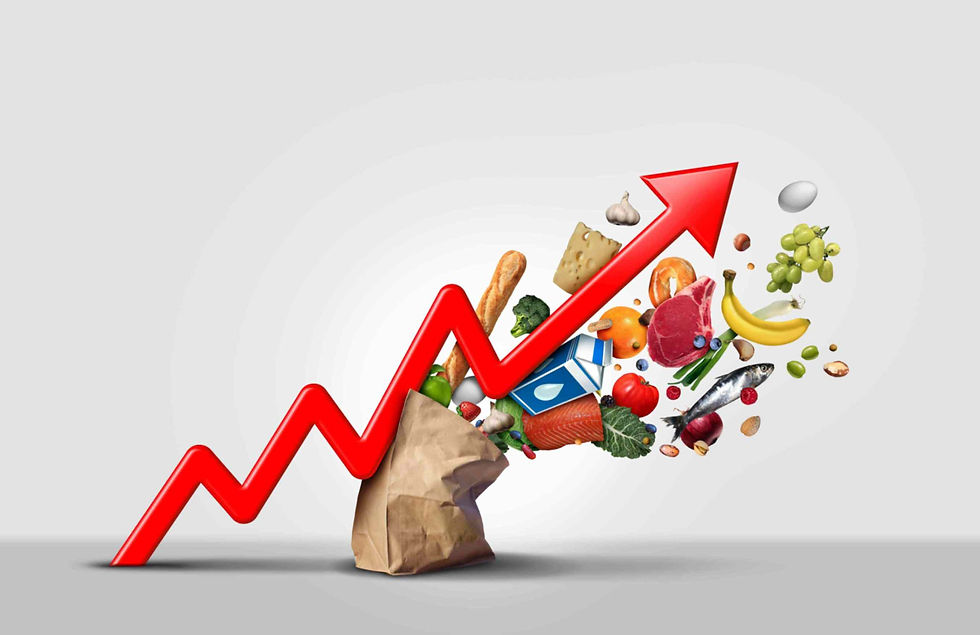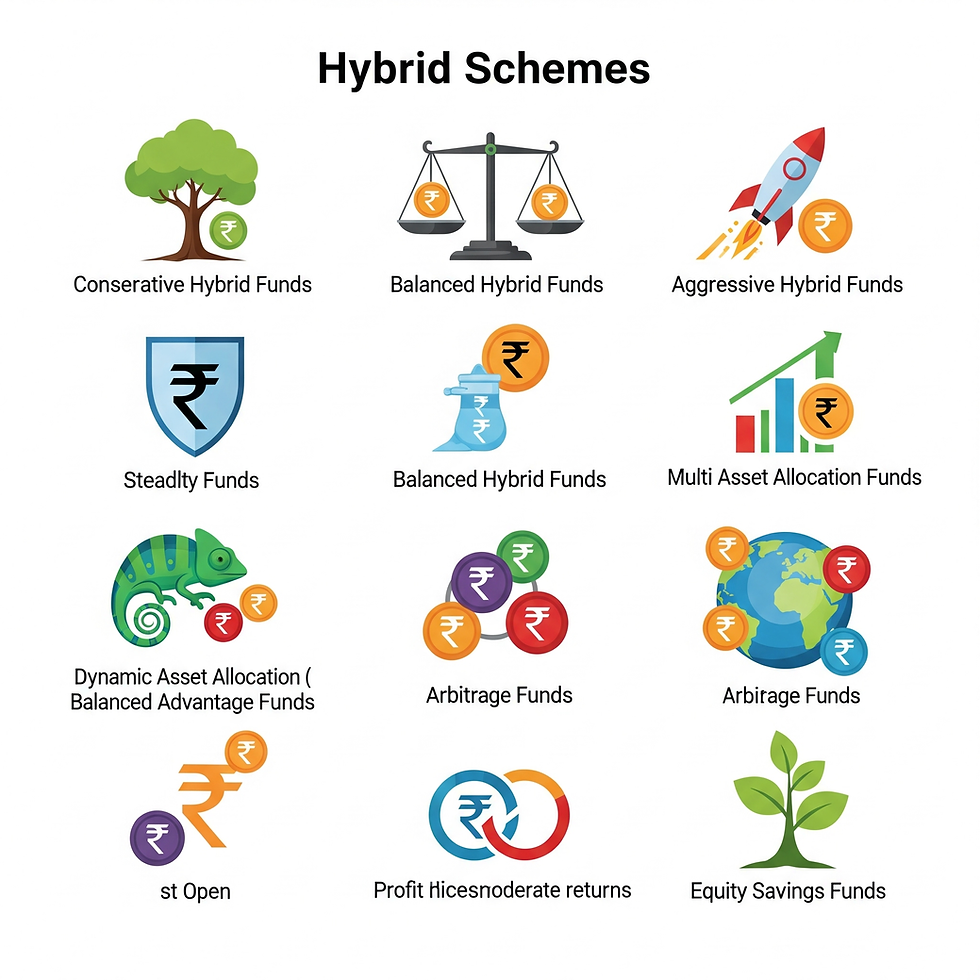History of Inflation in India
- M Manohar Rao
- Apr 9
- 6 min read

Tags: Wealth Management, Investment Lesson, Mutual Funds, Stock market, Budget, Finance, Investing, Personal Finance, Investment
Article Summary
• By studying the history of inflation in India, investors can better understand the impact of inflation on their savings and investment corpus for future needs.
• During periodic performance reviews, besides comparing returns with benchmarks, viewing performance in the backdrop of inflation trends can provide a truer picture of the progress towards goals.
• The history of inflation in India shows that the economy remains vulnerable to bouts of inflation, especially due to dependence on energy imports.
• Thanks to economic reforms and the government’s commitment to prudent fiscal management, spikes in inflation are far less pronounced.
We are aware of how inflation, over time, makes us dig deeper into our pockets to pay for the same set of household items. Inflation may also dent investments' ability to provide sufficient future income to meet expenses. Then, there are expenses such as higher education and healthcare that typically grow faster than general inflation. They require better financial planning keeping inflation in mind.
Why study history of inflation?
By studying the history of inflation in India, investors can estimate the amounts required for various major needs in the future. This includes major financial goals such as children’s higher education and retirement. This, in turn, determines the choice of investments such as equity and hybrid funds which aim for capital appreciation over a long tenure.
Further, during periodic performance reviews, besides comparing returns with benchmarks like those of mutual fund schemes, viewing them in the backdrop of prevailing inflation trends can provide a truer picture of progress towards financial goals.
As with other aspects of the economy, accurately predicting inflation rates is not possible. However, by studying the history of inflation in India, people can plan their investments and periodically assess their progress. Let us take a look at the brief history of inflation in independent India.
1950s
During this period, inflation measured through wholesale prices broadly remained under control in the first half of the decade. The reason: improved agricultural production. In fact, there was an inflation rate of -12.8%* in 1952-53 i.e., disinflation due to calming of food prices. However, it shot up in the decade’s second half and was 13.8% in 1956-57. This was due to increasing demand pressures as India embarked on its industrialisation drive, with inflation staying in the 3-7% band during 1957-58 to 1960-61.
1960s
Two wars, in 1962 and 1965, crisis in food production in the mid-1960s along with devaluation of the Rupee that made imports dearer, made the 1960s mostly a high inflation decade. Annual inflation measured by consumer prices was 10.80%** and 13.06%** in 1966 and 1967 before declining to the 3-5% band during 1968-70.
1970s
The inflation in the 1970s was easily the highest in the history of inflation in India. The Middle East conflict in 1973 triggered a global surge in oil prices. In India, a surge in prices of imported oil, coupled with poor agricultural production, led to unprecedented levels of inflation during 1973-74. While annual inflation already high at 6.44% in 1972, shot up to 16.94% in in 1973 and 28.60% in 1974, it subsequently declined as India experienced disinflation, clocking -7.63% in 1976.
Higher global oil prices troubled India again in 1979, rising to 6.27% and then shooting up to 11.35% in 1980 and 13.11% in 1981. However, India could deal with this bout of high inflation better than it did in the mid-1970s thanks to its higher food stocks.
1980s
This was also a decade of high inflation starting with 13.11% in 1981. The average inflation during 1982-89 also remained an extremely high 8.45%. This was primarily due to government spending not keeping up with its revenues. As a result, the government had to print more money which chased the existing supply of goods and services, substantially pushing up inflation.
1990s
Spike in global oil prices due to conflicts in Persian Gulf countries raised prices of imported oil and pushed up inflation in India to 8.97%. The First Gulf War in 1991 further accentuated the situation further leading to spike in oil prices and inflation at 13.87% in 1991. This also coincided with two step devaluation of the rupee that made the imports costlier and substantially pushed up prices during 1990-92, with inflation being at 11.79% in 1992. However, constant economic reforms ushered in 1991, helped reduce inflationary pressures substantially by the end of the decade, with inflation coming down to 4.67% in 1999.
2000’s
Starting of the decade was one of the periods of lowest inflation in the history of inflation in India. Economic reforms and ample food stocks helped India see through periods like 2002-03 when agricultural production was impacted due to a drought. Also helpful were factors like lower taxes, greater competition, and lower input costs. However, the country experienced high inflation during 2008 with rising global oil prices with an inflation rate of 8.35% that year. The high inflation continued at 10.88% and 11.99% in 2009 and 2010, respectively.
2010s
India was again affected by a bout of high inflation during 2011-2013. In 2013, weakening of the rupee, pushed up prices of essential imports like petroleum and associated products, making inflation touch a high of 10.02%. From 2014 till 2019, for most of the remaining years of the decade, inflation remained at 3.5-4.0% range. This was in no small measure due to the government and the RBI adopting an inflation tolerance band for annual inflation rate in the range of 4-6%.
2020s
The onset of the global pandemic in 2020, the near stalling of most global economic activities and then the subsequent opening up created massive supply disruptions across the globe, including India. This pushed up inflation in India to 6.7%* in 2022 which came down to 5.5%# in 2023.
Lessons from History of Inflation In India
One of the major lessons investors can draw from the history of inflation in India is that the country remains quite vulnerable to periods of high inflation. This is especially so when the costs of its energy imports, accounting for a significantly high portion of its energy demands, suddenly go up. This often occurs due to supply shocks or weakening of the rupee vis-a-vis the dollar.
Of course, over time, thanks to economic reforms and the adoption of a roadmap for responsible financial management by the government, the degree of spikes in inflation has been contained. The 4-6% annual inflation tolerance band adopted by the RBI, gives investors a benchmark to plan their investments, conduct financial planning and periodically review the performance of their investments.
FAQs
1. Is zero inflation ideal for investors?
Experts opine that there always needs to be a moderate inflation level in the economy to ensure its vitality. Very low inflation can be an indicator of low demand which may result in low economic growth and eventually impact investments such as equities.
Investors need to be vigilant during periods of sharp spikes in inflation. They can only be countered with long term investments in higher risk options such as equities which typically provide high return. Or investments in gold, delinked from economic cycles.
2. Why do inflation figures in news headlines sometimes feel lower than prevailing inflation?
Inflation figures are based on the basket of goods and services whose prices are tracked over time. For many consumers spending more on certain items, or those items outside the list, may translate into a higher inflation for them. For instance, healthcare and higher education services. Also, the place of residence tends to make a substantial difference in inflation experienced.
Disclaimer:
The information set out above is included for general information purposes only and is not exhaustive and does not constitute legal or tax advice. All complaints regarding Mutual Fund can be directed towards visit www.scores.gov.in (SEBI SCORES portal). Readers are requested to make informed investment decisions and consult Chaitanya Financial Consultants – 9000628943 / mfd.mmr@gmail.com to determine the financial implications with respect to investing in Mutual Funds.
Mutual Fund investments are subject to market risks, read all scheme related documents carefully.
Join WhatsApp group for better and personalised communication regarding investment lessons, advice and help.
Note: Members of our WhatsApp group will enjoy lifetime free investment advice and will not be charged any consultation fee for mutual fund investments.
Support My Mission – Your Small Contribution Matters!
I am passionate about sharing financial knowledge and guiding people toward financial independence. Through my articles, I strive to provide valuable insights that can help you make smarter investment decisions and secure your future.
If my work has added value to your financial journey, I would truly appreciate your support. A small contribution from you—whatever amount you feel is right—will go a long way in motivating me to continue creating high-quality content.
💰 You can support me via:
✔ Paytm / Google Pay / Amazon Pay: 9000628943
✔ PayPal: manomatt@rediffmail.com
Every small payment is not just financial support—it’s an encouragement that fuels my passion for educating and empowering others. Thank you for being a part of this journey! 🙏
Here’s your chance to earn extra money effortlessly. Simply refer someone to invest in any mutual fund scheme, and as soon as they invest, you'll receive ₹100 - ₹200 instantly in your bank account via Paytm or PhonePay. Start referring and start earning today!



Comments